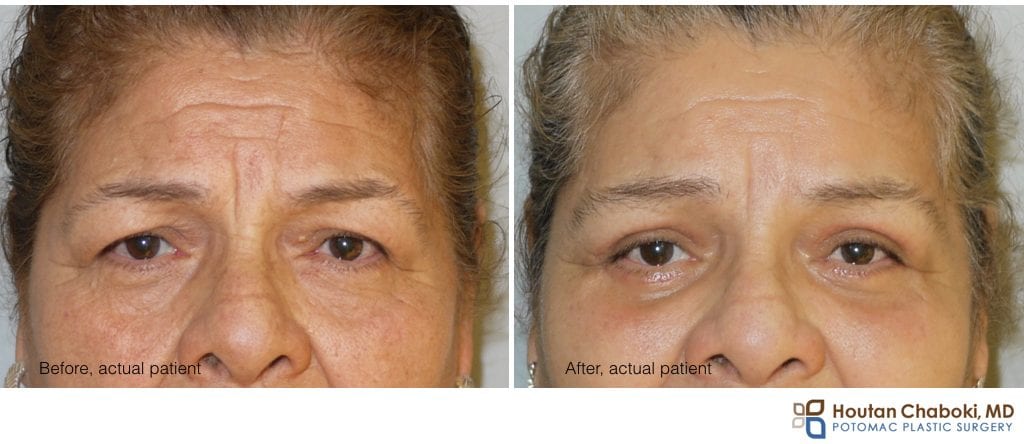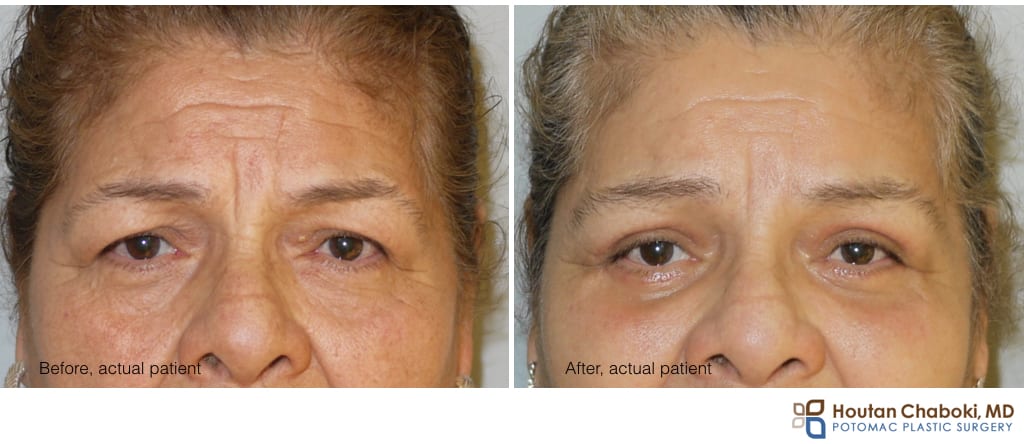Treatments of Botox and Dysport® are popular to relax wrinkles and improve one’s appearance without surgery. These nonsurgical treatments, along with facial fillers, are commonly performed in the upper regions of the face such as in the forehead, in between the eyes, and sides of the eyes (i.e. crow’s feet).
These periorbital areas are also considered during brow lift surgery evaluation. The forehead and periorbital (around the eyes) areas develop wrinkles, shrink, and fall with age. A brow lift helps lift and stabilize the brow, whether performed alone or in combination with upper blepharoplasty (i.e eyelid surgery). Brow lift surgery repositions tissue and may also modify the muscles around the eyes and forehead for smoother skin.
Different types of brow lifts allow plastic surgeons to tailor the surgery to the needs of the each patient. A coronal brow lift, the oldest and most traditional approach, allow surgeons wide, open access to modify the forehead as needed. A long incision is made across the scalp, from ear to ear. The coronal brow lift has the longest incision and the most downsides compared to alternative brow lift techniques. It’s still a valuable technique for some patients, but less commonly required due to newer plastic surgery techniques.
Modern brow lift surgery is performed by smaller, limited incisions or an endoscopic (video camera) approach. Smaller incisions hidden in the hairline allow appropriate access to the forehead to modify as needed. The brow is still lifted, but there is limited access to modify forehead muscle as compared to the older coronal approach..
To keep skin smooth, patients should understand that wrinkle relaxers and/or facial fillers may still be required to maintain a smoother forehead. Possible reasons to want non-surgical treatments after brow lift surgery may include:
- Brow lift surgery does not remove forehead muscle, the muscle treated with wrinkle relaxers such as Botox
- Brow lift surgery does not directly affect the skin surface. Deep wrinkles may still need to treated with facial fillers, chemical peels, or laser resurfacing.
- Plastic surgeons can setback, but can’t stop the “aging clock”. Wrinkles continue to develop with time, and the face continues to shrink from volume loss. Results with surgery are permanent, but you still keep getting older.
- Facial aging is a multidimensional process involving all tissues. It’s simply not just sagging of tissue.
The above before and after photographs demonstrate why a person may continue to want Botox or similar medications to further smooth the skin. This patient had deep forehead wrinkles which improved after cosmetic surgery. She is very happy with her more natural, youthful, and refreshed appearance. For further improvement and smoother skin, however, Botox (or Dysport) could be used in the forehead area.
Have you considered brow or eyelid surgery? Share your thoughts.



How long after an endoscopic brow lift may botox be injected?
Thank you for reading our blog! We typically wait a few weeks after brow lift surgery before considering Botox injections of the forehead.
Best,